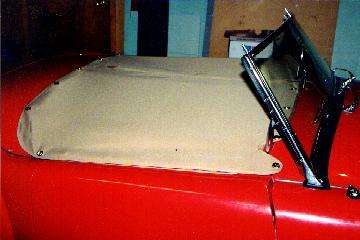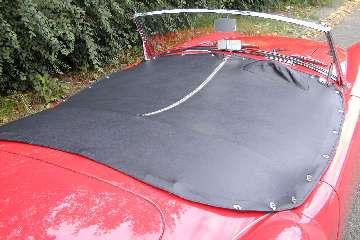The MGA With An Attitude
TONNEAU COVER TECH - TT-100
TT-100 describes six different styles of tonneau cover which you may find on an MGA, only two of them being original factory issue.
At 12:15 AM 11/27/03 -0500, Michael Ohleger wrote:
>"I'm selling a tonneau for an MGA 1600 .... but so far I have received questions from 3 people asking me if this is a long or short tonneau. I wasn't aware that there was ever a long tonneau offered for the MGA, any model, factory or aftermarket.. Anyone know?"
There are actually three different lengths.
 The one traditionally called "long tonneau cover" attaches to lift-the-dot machine screw studs attached to the sheet metal tonneau panel on the body just behind the rear cockpit rail. The factory used six studs here, and also attached the cover to the quarter turn fasteners mounted on the cockpit trim rails immediately aft of the door opening. This one is by far the most common style, and MIGHT have a standard fastener pattern, as they were installed this way on the production line (but not necessarily on all cars). Sometimes these covers can be switch from car to car (but not all cars) with the body mounted studs in the same location. Any car not fitted with a tonneau cover at the factory may have the studs in different locations.
The one traditionally called "long tonneau cover" attaches to lift-the-dot machine screw studs attached to the sheet metal tonneau panel on the body just behind the rear cockpit rail. The factory used six studs here, and also attached the cover to the quarter turn fasteners mounted on the cockpit trim rails immediately aft of the door opening. This one is by far the most common style, and MIGHT have a standard fastener pattern, as they were installed this way on the production line (but not necessarily on all cars). Sometimes these covers can be switch from car to car (but not all cars) with the body mounted studs in the same location. Any car not fitted with a tonneau cover at the factory may have the studs in different locations.
As far as I know, all tonneau covers installed at the factory were the long type, attaching to the LTD studs on the body tonneau aft of the rear cockpit rail. Early 1500 cars had a wide tonneau cover with LTD studs on top of the doors. In December 1958 at (c)60637 (and Twin Cam 994) for LHD cars, and in February 1959 at (c)64332 for RHD cars, the door top studs were deleted, and the tonneau cover became slightly narrower. At the same time the steering wheel pocket was deleted, and the zipped became longer. End result is that factory installed tonneau covers were either long and wide, or long and narrow. There were also somewhat different stud patterns on the front body tonneau.
The one traditionally called "short tonneau cover" is only slightly shorter. It attaches with wood screw LTD studs attached to the rear cockpit rail. These aftermarket covers were either dealer or owner installed, having the advantage of not having to drill holes in the painted tonneau body panel. They are more rare, but they are seen occasionally. Some people might like to order one like this new as a replacement for a pre-existing one, assuming the LTD studs are already present in the rear cockpit rail. The short tonneau covers were also available in wide or narrow, depending on whether or not your car had the door top studs.
 The third length is much longer and attaches to the rag top mounting hooks farther back on the body tonneau. This has a pair of short flat steel straps in the rear hem attaching to the same tear-drop hooks used for the convertible top, and also attaching to the same LTD studs used for the rag top. These were for a while fairly popular as aftermarket covers, primarily due to the convenience of installation, not having to install any studs at the back of the cockpit. That could also be an advantage if the opportunity were to arise to have the homecoming queen sitting in that location. The extra long covers were also available in wide or narrow style.
The third length is much longer and attaches to the rag top mounting hooks farther back on the body tonneau. This has a pair of short flat steel straps in the rear hem attaching to the same tear-drop hooks used for the convertible top, and also attaching to the same LTD studs used for the rag top. These were for a while fairly popular as aftermarket covers, primarily due to the convenience of installation, not having to install any studs at the back of the cockpit. That could also be an advantage if the opportunity were to arise to have the homecoming queen sitting in that location. The extra long covers were also available in wide or narrow style.
The picture above (compliments of Walter Tange) shows an aftermarket extra long tonneau cover for an early production 1500 with the LTD studs on the doors. It also has the early style sewn in raised pocket for the steering wheel.
All six of these cover styles would attach to LTD studs on the scuttle (front body tonneau body panel) just ahead of the front cockpit rail. Those studs are most commonly flanged and attached with two sheet metal screws each. None of these covers were ever intended to attach directly to the front cockpit rail, as that rail was optionally either solid wood (very early) or soft rubber (with a thin plywood backing piece), which would not hold a lift-the-dot stud. For early production (1500 cars) there were six studs across the scuttle between the windscreen grab handles. Two of those studs were (originally) fairly close together near the rear view mirror, so the "unzip down the middle" cover would be held at the inside front corners. For 1600 type cars two of the LTD studs (center of each half) were deleted, leaving only the two in the center and one near each grab handle.
Early MGA, through late 1958, had four LTD studs on top of each door, the front one being at the very front corner of the door, and the others being on the aluminum door skin just outboard of the trim rail (see second photo above). This cover is wider than the others in order to reach these outboard studs on the doors. In December 1958 the door mounted studs were deleted, and one stud was added to the scuttle on each side outboard from the grab handle (see top photo). The shape of the cover was altered accordingly to reach this new stud, as well as being narrower. Restored cars may or may not have this outboard stud. Many restored early 1500 cars may have the door studs deleted.
In summary, tonneau covers could be short, long, or extra long, any of them being wide or narrow (six styles), and all of then being period correct accessories for concours show (although only two are factory issue). For any tonneau cover not fitted at the factory, all bets are off for the position of the fasteners. This is why most new tonneau covers are supplied with the fasteners not installed, but in a separate package, to be installed in the fabric at the time the cover is installed on the car.
Good luck selling your tonneau cover on eBay. Don't make any claim about it actually fitting the buyer's car. Also be aware of the possible confusion between the traditional "long tonneau cover" and the MUCH longer one which attaches to the rag top hooks.
|